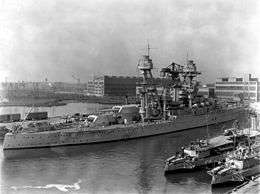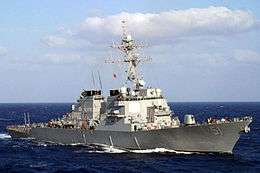Tripod mast
The tripod mast is a type of mast used on warships from the Edwardian era onwards, replacing the pole and lattice mast. Tripod masts are notable for using three large (usually cylindrical) support columns spread out at angles to brace each other.
_Port_Bow%2C_Underway_-_NARA_-_5900075_-_1930.jpg)


History
Tripod masts were predated by pole masts and lightweight lattice masts, a system which used an array of thin columns at angles, crossing each other in a double helical spiral configuration in a form of hyperboloid structure. The US Navy favoured the lattice mast which they used on their first battleships in 1906. The British Royal Navy preferred pole or tripod masts.
The masts were intended to provide a raised platform for visual observers and for fire control equipment, elevated up above the main hull for visibility and to reduce the risk of shell damage to the gear and crews. Lattice masts also accomplished those goals, but the masts proved less structurally sound than intended. On January 15, 1918, the USS Michigan (BB-27) had a lattice mast collapse in an intense storm.
Beginning in the 1930s, the US Navy started refitting their battleships and other capital ships with the more robust tripod mast design. These masts elevated the equipment and observer stations, but used three large cylindrical tubes or columns to form the mast rather than an open lattice. The tubes provided structural cross-bracing and a stiff structure, but were still structurally efficient and reasonably lightweight.
This basic mast structure, with three large tubes or columns, continued in use with the introduction of radar and were used on US warships until stealth designs started to move away from open masts entirely in the 2000s. The Royal Navy began using plated-in masts or "macks" in the early 1960s, either as new construction or by refit, such as that of HMS Salisbury in 1962.[1]
References
- ↑ Marriott, Leo, Royal Navy Frigates, 1945-1983, Ian Allan Ltd., p.50